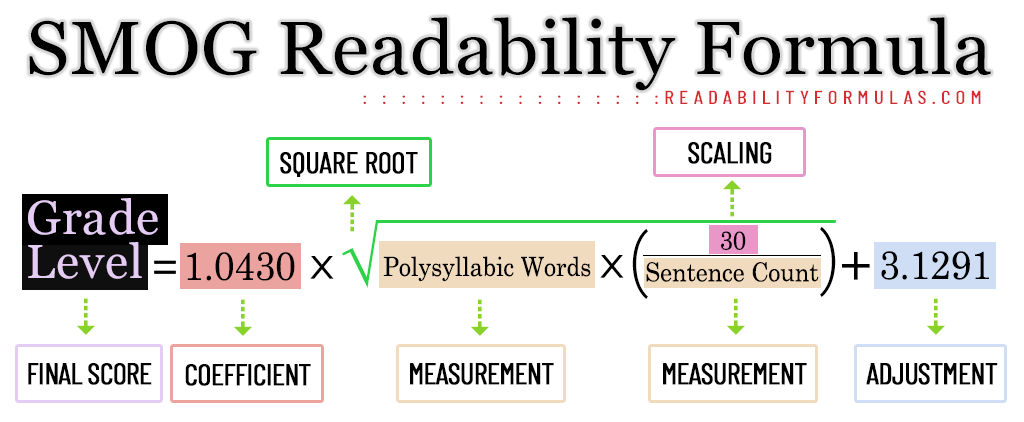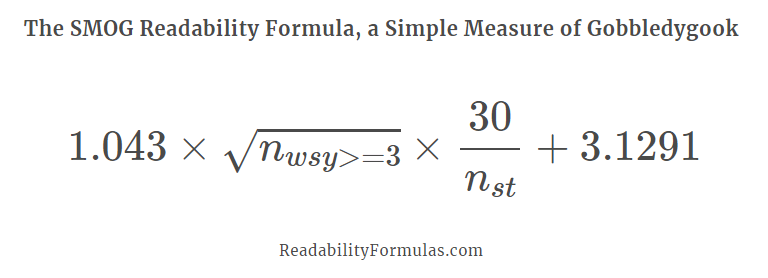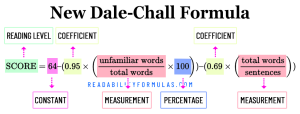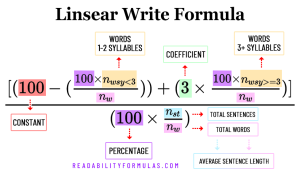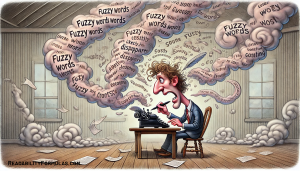The SMOG Index is a popular readability formula to estimate the years of education a person needs to understand a piece of writing on first reading. You may come across SMOG as an acronym for Simple Measure of Gobbledygook, but it’s widely believed the title is a nod to Robert Gunning’s FOG Index. The acronym “gobbledygook” humorously refers to language that is nonsensical or hard to understand.
The formula was developed by professor/linguist G. Harry McLaughlin, Ph.D. in 1969. He introduced his formula in an article titled, SMOG Grading–A New Readability Formula, published in the Journal of Reading. (The Journal of Reading was published by the International Reading Association, now the International Literacy Association.) SMOG relies on McLaughlin’s research that polysyllabic words ( words with three or more syllables ) can predict “reading difficulty” more accurately.
His formula is as follows:
SMOG Readability Formula
$$ 1.043 \times \sqrt{n_{wsy>=3}} \times \frac{30}{n_{st}} + 3.1291$$
where \(n_{wsy>=3}\) = the number of words with 3 syllables or more.
The result corresponds to a U.S. school grade level. A SMOG score of 10.69 suggests that the average 11th grader (around age 16-17) can comprehend the text.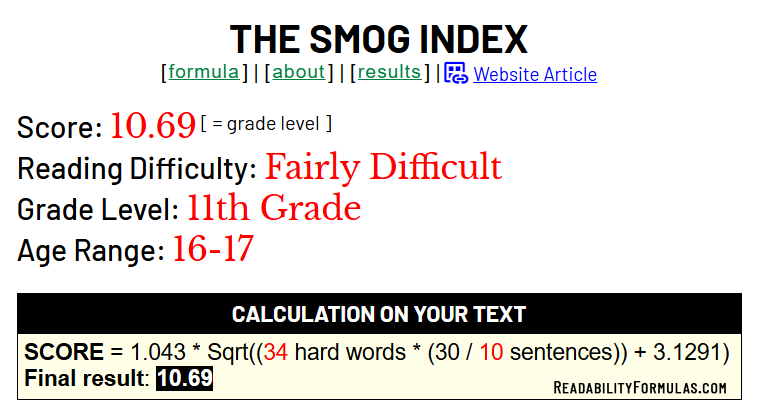
Understanding the Numbers in SMOG Formula
The numbers in the SMOG formula uses coefficients, scaling factors, and constants that adjust for accurate readability levels. Let’s break it down:
1.0430 (Scaling Coefficient)
- This coefficient adjusts the impact of the square root transformation.
- This number ensures the final output aligns with U.S. grade levels.
- McLaughlin determined this coefficient empirically by testing readability scores against real-world reading comprehension data.
Square Root Function
SMOG calculates the square root of the polysyllabic word count to account for the nonlinear relationship between word difficulty and reading level.
- As texts contain more polysyllabic words, readability increases at a decreasing rate.
- A linear formula would overestimate difficulty for highly polysyllabic texts.
- A square root function dampens the effect, making the results more realistic.
It Models Cognitive Load
- The effort readers need to process polysyllabic words follows a curve, not a straight line.
- A 10% increase in polysyllabic words does not cause a 10% increase in difficulty.
- The square root smooths this effect, reflecting how comprehension scales.
3.1291 (Intercept/Constant)
The original SMOG developed by G. Harry McLaughlin used +3 for practical, rounded readability grading. Newer refinements of SMOG use 3.1291 to improve accuracy. The difference is minimal: +3 vs. +3.1291 changes results by less than 0.2 grade levels.
- This constant shifts the final grade level to match real-world education levels.
- Without this adjustment, the formula would underestimate the grade level.
- It was derived from statistical analysis of readability data, ensuring texts align correctly with actual grade levels.
30 (Scaling Factor)
- The formula assumes a fixed sample of 30 sentences to ensure consistency when comparing texts of different lengths.
- The term (30 / sentence count) adjusts for texts with fewer or more than 30 sentences; it normalizes the polysyllabic word count proportionally.
- McLaughlin derived this number by analyzing real-world reading comprehension data. He found that analyzing 30 sentences gave the most stable and accurate readability estimates.
Why Use SMOG?
The SMOG Readability Formula is a widely validated tool for measuring text difficulty, offering key advantages:
- High Accuracy: SMOG is one of the most reliable readability measures, showing strong correlations with standardized reading comprehension tests, such as the McCall-Crabbs Standard Test Lessons and the Thorndike-McCall Reading Test. Research indicates that SMOG scores within 1.5 grade levels of actual reader comprehension levels.
- Ease of Use: Unlike some readability formulas that need specialized word lists (e.g., Dale-Chall) or complex sentence structure analysis, SMOG only needed counting polysyllabic words in a fixed number of sentences.
- Broad Applicability: The SMOG formula is effective across multiple domains, such as in educational materials, healthcare documents, and general publications.
SMOG is widely used by government agencies, educators, healthcare providers, and publishers to ensure materials are appropriate for their target audiences.
- Education: Used by schools and curriculum developers to align textbooks and reading materials with appropriate grade levels.
- Healthcare: The Centers for Disease Control and Prevention (CDC), Indian Health Service (IHS), and Harvard School of Public Health use SMOG to ensure patient education materials are understandable.
- Government & Public Health: Agencies like the Agency for Healthcare Research and Quality (AHRQ) and National Network of Libraries of Medicine (NNLM) recommend SMOG for assessing health-related content readability.
- Publishing & Media: Editors and content creators use SMOG to adapt materials for general audiences, ensuring accessibility across different reading levels.
Our Readability Scoring System lets you score your text using the SMOG formula.
Scott, Brian. “The SMOG Readability Formula, a Simple Measure of Gobbledygook.” ReadabilityFormulas.com, 7 Feb. 2025, https://readabilityformulas.com/the-smog-readability-formula/.
